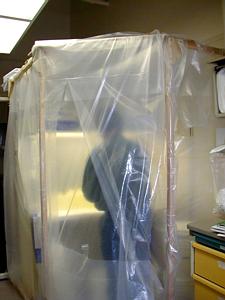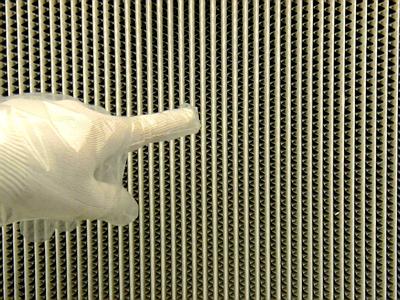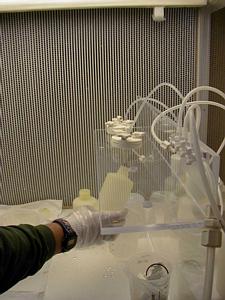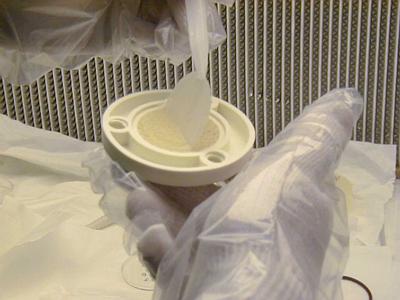2 December, 1999
McMurdo Station, Ross Island, Antarctica
Thursday
Bess and I continued to work at the gas chromatograph, deciding to accept
the fact that it will not work the way we would like for it to work. The
data that we were able to extract from the instrument appeared to be valid
data. It just takes us twice as long as before to run one sample. We have
almost 100 samples waiting to be analyzed! I have been pulling the morning
shift and Bess has been working from mid-morning until the wee hours of the
the next morning! Tomorrow, we will take shifts.
The weather has been playing havoc with travel plans. People at McMurdo who
have finished their work are anxious to get home, but they must wait until
the C-130 from Christchurch gets here! Because the C-130 didn't make it
from New Zealand, they have one more day to play! In fact, the C-130 was
turned around en route! This is called a boomerang flight. There is a
point at which the plane must either turn around and fly back to
Christchurch or continue on and land at McMurdo, regardless of the weather.
The weather at McMurdo had deteriorated today to the point that you couldn't
see the runway from town! This is unusual!
ANSWER TO YESTERDAY'S QUESTION: Moraines are deposits rock, dirt, and other
debris from the movement of a glacier. This material can be pulled or
pushed by the glacier and often interesting shapes are created.
TODAY'S QUESTION: No question today! You have the day off!
POLAR PROFILE: Trace metal clean technique...sounds a little strange. Much
like sterile technique to the microbiologist, trace metal chemists use trace
metal clean technique. Mark and Maite, two members of my research team,
work in trace metal chemistry. Mark took me on a tour of the trace metal
clean 'bubble' and explained to me the processes involved to make certain
that samples that we collect from Lake Bonney are not contaminated with any
metals. Because they want to measure the metals in the lake water, they do
not want to accidentally introduce metals from the outside. Even dust
contains some metal parcticles.
The bubble room that Mark and Maite created contains a ventilation system
that circulates air through a HEPA filter. This filter removes any metallic
parcticles that might be in the air. They wear special gloves so that metals
on their fingers do not contact any bottles or filters. They wear booties
so that they do not track metal-containing dust into their bubble room on
their shoes.
Once inside the bubble room, Mark and Maite filter the water samples that we
have collected from Lake Bonney. They save the material that is trapped by
the filter and also the filtrate (the water that passed through the filter).
They are interested in determining what metals are present, what is the
concentration of those metals in the water, are the metals bound to other
chemicals, and what percentage of the metals are dissolved or remain as
suspended parcticles. Every bottle is rinsed 5 times with ultra-pure water!
Acid is also used to wash the bottles to remove any traces of metals. Maite
even puts tape over any exposed pieces of metal in the bubble room! They
keep their bubble room pen, sponge for spills, and Kaydry's (extra large
tissues) attached to the ventilation hood! It's a very elaborate process!
Sharon
JUST FOR KIDS!!!!!
McMurdo Station, Ross Island, Antarctica
Thursday
Bess and I continued to work at the gas chromatograph (GC) and decided that
we would have to work with the GC just as it is! We were able to get
results of the gases in the water, but it took a very long time!
The weather has kept the plane from New Zealand from landing at McMurdo. In
fact, the C-130 was turned around on its way here! This is called a
boomerang flight. There is a point at which the plane must either turn
around and fly back to Christchurch or continue on and land at McMurdo,
regardless of the weather.
ANSWER TO YESTERDAY'S QUESTION: Moraines are deposits rock, dirt, and other
debris from the movement of a glacier. This material can be pulled or
pushed by the glacier and often interesting shapes are created.
TODAY'S QUESTION: No question today! You have the day off!
POLAR PROFILE: Trace metal clean technique...sounds a little strange. Mark
and Maite, two members of my research team, work in trace metal chemistry
(they study chemicals like iron, copper, and magnesium). Mark took me on a
tour of the trace metal clean 'bubble' and explained to me how they make
certain that samples that we collect from Lake Bonney are not contaminated
with any metals. Because they want to measure the metals in the lake water,
they do not want to accidentally introduce metals from the outside. Even
dust contains some metal parcticles.
The bubble room that Mark and Maite created contains a ventilation system
that moves air through a HEPA filter. This filter removes any metal
parcticles that might be in the air. They wear special gloves so that metals
on their fingers do not contaminate any bottles or filters. They wear
booties so that they do not track metal-containing dust into their bubble
room on their shoes.
Once inside the bubble room, Mark and Maite filter the water samples that we
have collected from Lake Bonney. They are interested in finding out what
metals are present and how much of those metals are in the water. Every
bottle is rinsed 5 times with ultra-pure water! Acid is also used to wash
the bottles to remove any traces of metals. Maite even puts tape over any
exposed pieces of metal in the bubble room! They keep their bubble room
pen, sponge for spills, and Kaydry's (extra large tissues) attached to the
ventilation hood! It's a very elaborate process!
Sharon

This is the 'bubble room'! Mark is inside filtering samples.

The HEPA filter for the 'bubble room'. The entire back wall of the bubble room hood houses the filter that cleans the air of trace metals.

Mark filtering the Lake Bonney water samples in the bubble room. Note the HEPA filter in the background.

Our bootie-clad feet in the bubble room. We are also standing on a sticky mat that helps to remove any parcticules from your feet.

Mark removing a filter from the filter apparatus. Mark is wearing gloves and using special forceps so that he doesn't contaminate the sample.
Contact the TEA in the field at
.
If you cannot connect through your browser, copy the
TEA's e-mail address in the "To:" line of
your favorite e-mail package.
|
